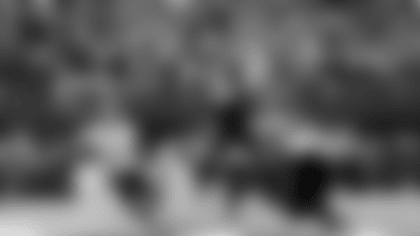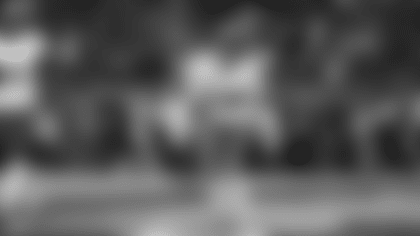The terms "bold" and "iconic" have been used frequently to describe the design of U.S. Bank Stadium, but another phrase, "authentic sustainability," has been important since its inception.
As the state-of-the-art venue approaches completion this summer, today's celebration of Earth Day is an opportunity to illustrate several behind-the-scenes green aspects of a building that will be linked with Vikings purple.
The Vikings, MSFA and architectural firm HKS aimed to garner LEED (Leadership in Energy & Environmental Design) certification from the start.
Texas-based John Hutchings, HKS's sports principal-in-charge of U.S. Bank Stadium, told Vikings.com in a phone interview Thursday that the form of the building, with its distinctive and asymmetrical, high-pitched roof is a "direct response to your harsh climate."
The purpose is to shed snow off the roof efficiently into a giant snow gutter near the roof line that features a heating system to direct the melted snow through the stadium's storm water control system. The roof's ability to shed snow quickly enabled designers to utilize one central ridge truss and lessen the carbon footprint of the building by reducing the needed structural steel by an estimated 2,000 tons.
The design, Hutchings said, drew influences from Northern European architecture of the past, before modern heating and cooling machinations, "where sustainability has long been an important element of design."
"We took that as one of our design drivers from the outset, knowing that we were going to do something unique in terms of a sustainable approach," said Hutchings, who added that the multiple purposes of the stadium will further boost its sustainability.
"Once you start utilizing a building a lot more frequently, the concern with the sustainable approach to design enters into the equation to a much greater degree," Hutchings added.
Energy Conservation
The green initiatives of the roof don't stop at its form. The selection of ETFE — a clear, plastic-like, Space Age material — for 60 percent of the roof covering makes U.S. Bank Stadium the first building in the United States to use the material at this scale and includes multiple green benefits:
- The weight reduction from using ETFE instead of steel helped reduce demand for structural steel.
- The south-facing orientation of the ETFE part of the roof will capitalize on sunlight, allow solar thermal heating and reduce the demand for artificial lighting.
- Solar thermal heating will create a heat reservoir during the winter that will allow warm air to be redistributed by reversing the fans and ducts that distribute cold air in the summer.
"It's a cool thing, or in this case, a warm thing," Hutchings said with a laugh.
The Metrodome used 104 kilo British thermal units per square foot, but U.S. Bank Stadium will use 92 kBTU/sf because of the venue's advanced air handling units, improved ventilation and high-efficiency motors.
U.S. Bank Stadium will be able to efficiently handle the broad range of exterior temperatures in the Twin Cities climate from subzero Fahrenheit in the winter to the 90s in the summer.
Hutchings said the building could require some cooling even on late-season Vikings game days when more than 66,000 fans turn out and turn up to support the team.
"What most people don't realize, is with [that many] people giving off heat, even in the middle of the winter, you're in a cooling mode normally because of the people load in the facility," Hutchings said. "Of course in the summer, you really do need [the cooling], which is why we have the degree of fritting that we do on the ETFE, so we don't let in too much radiant heat."
U.S. Bank Stadium is the first new NFL venue to be built with an advanced LED lighting system at the start of the building that will allow for instant on-and-off capabilities, be conducive to the building's multiple purposes and provide an estimated energy savings of **more than 75 percent*** *over metal halide lights. The Vikings paid $1.3 million beyond their initial commitment to upgrade the lighting system.
"It's much more energy efficient to use the LEDs for sports lighting because you have them on an hour or two before an event and an hour or two after an event," Hutchings said. "It's quite sustainable, and we were glad the Vikings stepped up to the plate and paid extra to get the LED lighting for the sports lighting."
Water Conservation
Low-flow technology for plumbing is expected to reduce water usage considerably, an anticipated 37 percent below code requirements, equaling 5.67 million gallons of water per year.
"We end up producing something that is better than the minimum, which is typically a code requirement for a given criteria," Hutchings said. "You have to meet code, and where you exceed code, we use code as the baseline. You have a pretty forward-thinking set of codes in Minnesota to start with, so anything that's an improvement or betterment over your baseline of code is quite sustainable."
A water-efficient irrigation system will reduce the landscape irrigation use while providing for native plantings outside the building.
Indoor-outdoor feel
Hutchings, who worked in the same capacity on Lucas Oil Stadium in Indianapolis, Miller Park in Milwaukee and the American Airlines Center in Dallas, said some of his favorite elements of U.S. Bank Stadium have not been part of any other sports venue.
He listed the ETFE roof, the proximity fans will have to the field and the five mammoth pivoting glass doors on the west side of the building as his favorites. The doors will open onto a 4.2-acre green space, Medtronic Plaza and the Light Rail Transit station. They will allow an indoor building to stay connected to the outdoors.
"The operable doors are going to be a hoot, I think, just because there's nothing like them in the world," Hutchings said. "It will make that west plaza — I just think this is the first stadium that we've done that has this much integration before we even open it."
Timeline of LEED certification decision
There are four rating levels for LEED: certified, silver, gold and platinum. Buildings can score points in nine categories:
1) Integrative process
2) Location and transportation
3) Sustainable sites
4) Water efficiency
5) Energy and atmosphere
6) Materials and resourcefulness
7) Indoor environmental quality
8) Innovation
9) Regional priority
The impact that U.S. Bank Stadium has had in spurring development around it, its proximity to the LRT and connectivity to the Minneapolis skyway system, and the green initiatives for design and operation are expected to score well for the project.
The determination of U.S. Bank Stadium's LEED certification won't occur until after the building opens.
"We have to get documentation during the construction process for compliance, and a big portion of this is the commissioning of the stadium and the stadium systems, so the commissioning holds up the final submission to the USGBC for final certification," Hutchings said. "We are going to try to push for an early review of the USGBC based on our submission, but it doesn't happen until after the commissioning of the systems."
Green Operations
As the new building was in its early stages of construction, crews managed to recycle/repurpose approximately 90 percent of the Metrodome.
U.S. Bank Stadium will implement a green cleaning program and institute a comprehensive, commingled recycling program.














